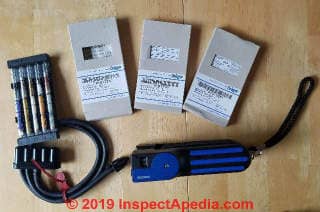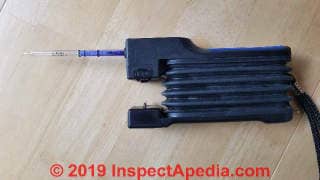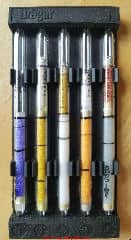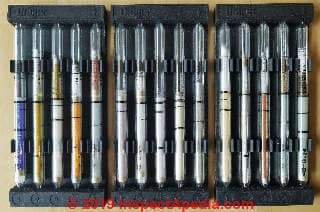 Hazardous Gases from Fires
Hazardous Gases from Fires
Detection, Exposure Limits, Warnings
- POST a QUESTION or COMMENT about how to detect & measure hazardous gases in buildings
This article lists a range of toxic gases that are commonly found at building or other fire scenes.
We include an example of tests for measuring the level of toxic or dangerous gases in or around buildings during or after a fire using Dräger Simultantest gas detection tubes and a manifold that permits conducting five tests at once. .
This article series discusses tools and methods used to test for the level of toxic and other gases in buildings and in outdoors. In related documents we give references and explanation regarding toxicity of several of the most common indoor gases, based on literature search and obtained from the U.S. government and expert sources.
InspectAPedia tolerates no conflicts of interest. We have no relationship with advertisers, products, or services discussed at this website.
- Daniel Friedman, Publisher/Editor/Author - See WHO ARE WE?
Special Hazardous Gas Detection for Firefighters & Civil Defense - During & Post Fire Off-Gassing Hazards
 Draeger (Dräger) provides a wide rage of gas detection tubes used with a simple hand pump - shown here.
Draeger (Dräger) provides a wide rage of gas detection tubes used with a simple hand pump - shown here.
Draeger also provides portable or wearable monitoring devices for firefighter safety such as the Dräger X-pid® 8500 that measures hazardous toxic substances such Acrolein, Benzene, Butadiene, Dichloroethylene, Ethyl benzene, Ethylene oxide, Hexane, Isobutylene, Propylene oxide, Styrene, Tetrachloroethylene, Toluene, Trichloroethylene, Vinyl chloride, Xylene,and other VOCs,
or the Dräger X-am® 8000 that for fire clearance measurement, measures up to seven gases such as CO2, O2, CO, HC, H2, H2S, NO, NO2, SO2, PH3, HCN, NH3, Amine, Odorants, Ozone,, including toxic, flammable gases and vapors, and oxygen all at once.
For use by firefighters and fire investigators, and for Civil Defense workers, Draeger provides a special manifold (shown at page top) for the company's gas detector hand pump.
The manifold, shown at the top of this page is used with a special set of gas detector tubes permits multiple samples (typically five) to be collected simultaneously to screen for a very wide range of toxic gases which may be present at a fire scene.
Three sets of 5 gas detection tubes, Drager Simuiltantest Set I, II, and III shown below cover a wide range of common toxic gases released during fires.
- Dräger Simultantest-Set I, # 8101735, inorganic gases released during fires, detects hydrochloric acid, hydrocyanic acid, carbon monoxide, ammonia, and nitrogen dioxide.
- Dräger Simultantest-Set II, # 8101736, inorganic gases released during fires, detects sulphur dioxide, chlorine, hydrogen sulfide, carbon dioxide, and phosgene
- Dräger Simultantest-Set III, #8101770, organic vapours, detects ketones, aromatic hydrocarbons, alcohols, aliphatic hydrocarbons, and chlorinated hydrocarbons.
Watch out: the contents of many gas detection tubes are themselves harmful on skin-contact such as containing corrosive chemicals. Avoid skin contact with the contents of the tubes and follow safe disposal guidelines listed in the tube use instruction pamphlets.
In three tables below we summarize Draeger's Simultantest detection substances, including examples of measurable source substances in each category, and for each category reporting range of the detector tubes in ppm corresponding to marks on the detector tube..
| Dräger Simultantest-Set I, # 8101735, inorganic gases released during fires | |||
| Combustion or Carbonisation Product |
Typical Source |
Detected Substance |
ppm Mark 1 / 2 |
| Hydrochloric acid | Chlorinated hydrocarbons, chlorine-containing synthetics, PVC, chloroprene | HCl | 5 / 25 |
| Hydrocyanic acid | Polyurethanes (Moltopren), Celluloid, Polyacrylonitrile, Nylin, wool, silk | HCN | 10 / 50 |
| Carbon monoxide | Carbon compounds (excluding carbonates), hydrocarbons, ... wood, other plant material, esp. in fires where there is little oxygen | CO | 30 / 150 |
| Ammonia | Polyamides, expoxy resins, melamine resins, wool, silk | NH | 50 / 250 |
| Nitrous fumes | Nearly all fires | NO2 | 5 / 25 |
Notes to the Table Above
Watch out: the company warns that Even though the simultaneous test may present a negative result, the presence of other harmful gases cannot be precluded. [Also] The simultaneous test has not been designed for detetdion of explosion hazards.
These tubes may be used only with the following Dräger pumps: Model 21/31, Accuro, Accuro 2000, Quantimeter 1000. Using other pumps may result in significant measurement errors.
Source: Dräger Safety AG & Co., KGaA, Germany, Publication No. 90 22 415, 4th Ed., December 2001 (the company can provide more-recent versions of this data)
Contact: Dräger Systems (also written Draeger) Draeger, Inc. 7256 S. Sam Houston W Pkwy., Suite 100 Houston, TX 77085 USA, +1-800-437-2437 Website: https://www.draeger.com
| Dräger Simultantest-Set II, # 8101736, inorganic gases released during fires | |||
| Combustion or Carbonisation Product |
Typical Source |
Detected Substance |
ppm Mark 1 / 2 |
| Sulphur dioxide | Heating oil containing sulphur, coal, peat, proteins & amino acids containing sulphur, wool, silk | SO2 | - / 10 |
| Chlorine | Chlorinated hydrocarbons | Cl | - / 2.5 |
| Hydrogen sulphide | Organic sulphur compounds | H2S | 10 / 50 |
| Carbon dioxide | All combustible organic chemicals and substances | CO2 | 5000 / 25,000 |
| Phosgene | Chlorinated hydrocarbons,organic acid chlorides, synthetics containing chlorine | COCl2 | - / 0.5 |
Notes to the Table Above
Watch out: the company warns that Even though the simultaneous test may present a negative result, the presence of other harmful gases cannot be precluded. [Also] The simultaneous test has not been designed for detetdion of explosion hazards.
Before using any of these gas detector tubes it is essential that you read the details in the product enclosure provided by Dräger Safety. There you will see the limitations of the test, allowable operating temperature range (typically 10 to 30° C) and humidity range (typically 5 to 15 mg H2O / L), substances that cause errors or variations in readings, and other sensitivity and use advice that is critical in understanding and using the detector tube test result safely.
Source: Dräger Safety AG & Co., KGaA, Germany, Publication No. 90 22 417, 4th Ed., January 2002 (the company can provide more-recent versions of this data)
These tubes may be used only with the following Dräger pumps: Model 21/31, Accuro, Accuro 2000, Quantimeter 1000. Using other pumps may result in significant measurement errors.
| Dräger Simultantest-Set III, #8101770, organic vapours | ||||
| Solvent Category | Typical Source |
Detected Substance |
ppm Mark 1 / 2 |
Color Change |
| Ketones | Acetone, methyl ethyl ketone, methyl isobutyl keytone | C3H6O Acetone | 1000 / 5000 | light yellow -> dark yellow |
| Aromatic hydrocarbons | Toluene, xylene, benzene | C7H8 Toluene | 100 / 500 | white -> brown |
| Alcohols | Methanol, ethanol, propanol, butanol | CH3OH Methanol | 200 / 1000 | orange -> brown |
| Aliphatic hydrocarbons | Gasoline*, light benzine of varying boiling ranges, petroleum, kerosene, fuel oil | C6H14 n-hexane | 50 / 100 | white -> brown |
| Chlorinated hydrocarbons | Perchlorethylene (tetrachloro-ethylene), methylene chloride (dichloromethane) | C2Cl4 | 50 / 100 | yellow-white -> grey-blue |
Notes to the Table Above
 * In some instances such as the detection of aliphatic hydrocarbons (sources include gasoline, light bensine of different boilingin ranges, petroleum, kerosene, fuel oil), Draeger points out that non premium grade and premium-grade gasoline also contains benzene and other aromates in differering portions.
* In some instances such as the detection of aliphatic hydrocarbons (sources include gasoline, light bensine of different boilingin ranges, petroleum, kerosene, fuel oil), Draeger points out that non premium grade and premium-grade gasoline also contains benzene and other aromates in differering portions.
Watch out: Explosion hazard warning: Dräger's instructions for Simultantest III notes that
The simultaneous test has not been designed for detection of explosion hazards. It is therefore recommended to make use of the Dräger Pac Ex for constant monitoring.
However, discoloration of the tube over its entire length during the course of the first few strokes always indicates an explosion hazard (except where the tube for chlorinated hydrocarbons is concerned).
Note: in the original publication included with this detector tube set the Application Range table rows were not in corresponding order to the solvent category rows - amended in our presentation.
Watch out: using any gas detection instrument without a thorough understanding of the tool, the environment, and the potential hazards for which one is screening can be dangerously inaccurate: be sure to
read GAS DETECTOR WARNINGS . These tubes may be used only with the following Dräger pumps: Model 21/31, Accuro, Accuro 2000, Quantimeter 1000. Using other pumps may result in significant measurement errors.
Sources:
- Dräger Safety AG & Co., DRÄGER SIMULTANEOUS TEST SETS, DRÄGER-TUBES [PDF], CORPORATE HEADQUARTERS Drägerwerk AG & Co. KGaA Moislinger Allee 53–55 23558 Lübeck, Germany www.draeger.com Customer Service: USA +1 800-4DRAGER (+1 800-437-2437) . CANADA +1 877-DRAGER1 (+1 877-372-4371) . Technical Service: USA +1 800-4DRAGER (+1 800-437-2437), retrieved 2019/05/09, original soirce: https://www.draeger.com/Products/Content/simultaneous-test-sets-pi-9102994-en-us.pdf
- Dräger Safety AG & Co., KGaA, Germany, Publication No. 90 22 438, 5th Ed., May 2004 (the company can provide more-recent versions of this data)
Find NIOSH IDLH-Value for Gas Exposures: Immediately Dangerous to Life and Health
Watch out: in gas detection tube instructions and in other publications Dräger as well as other gas detector tube manufacturers point out that when evaluating the harmful gas level read using a gas detection device:
When evaluating toxic gases, the IDLH-value (Immediately Dangerous to Life and Health) may be used. This gives the maximum concentration at which a person without protective breathing equipment must leave an affected area within 30 minutes.
The IDLH-values are listed in the NIOSH Pocket Guide to Chemical Hazards, NIOSH: National Institute for Occupational Safety and Health, USA. [US CDC]
Excerpt: The NIOSH Pocket Guide to Chemical Hazards is intended as a source of general industrial hygiene information for workers, employers, and occupational health professionals.
The Pocket Guide presents key information and data in abbreviated tabular form for 677 chemicals or substance groupings (e.g., manganese compounds, tellurium compounds, inorganic tin compounds, etc.) that are found in the work environment. The industrial hygiene information found in the Pocket Guide should help users recognize and control occupational chemical hazards.
The chemicals or substances contained in this revision include all substances for which the National Institute for Occupational Safety and Health (NIOSH) has recommended exposure limits (RELs) and those with permissible exposure limits (PELs) as found in the Occupational Safety and Health Administration (OSHA) General Industry Air Contaminants Standard (29 CFR 1910.1000).
Source: retrieved 2019/05/09, https://www.cdc.gov/niosh/npg/pgintrod.html
To search for the CAS numbers for toxic substances use either
- US CDD / NIOSH IIndex of Chemical Names, Synonyms and Trade Names found online at https://www.cdc.gov/niosh/npg/npgsyn-a.html#
- US CDD / NIOSH Index of Chemical Abstracts Service Registry Numbers (CAS No.) found online at https://www.cdc.gov/niosh/npg/npgdcas.html
Clicking on any substance name gives its synonyms, trade names, formula, physical description, health effects, and IDLH number, typically in ppm.
Example, using Hydrochloric acid, the first substance detected in the Dräger Simultantest-Set I, # 8101735 we would search either of those pages for hydrogen chloride (HCl) to find CAS No. 7647-01-0 Hydrogen chloride.
The second web page of CAS Numbers includes a live link for CAS No. 7647-01-0 Hydrogen chloride.
Clicking that link for hydrogen chloride gives synonyms, trade names, fromula, and various exposure limits. The CDC/NIOSH page for each of these substances will also describe exposure routes and symptoms, personal protection recommendations, etc.
You would compare that number to the levelof HCL detected in the environment being examined.
Hydrogen chloride - HCL Exposure Limits
- IDLH: 50 ppm
- NIOSH REL C 5 ppm (7 mg/m3)
- OSHA PEL C 5 ppm (7 mg/m3)
...
Continue reading at Drager GAS DETECTORS or select a topic from the closely-related articles below, or see the complete ARTICLE INDEX.
Or see these
Recommended Articles
- COLORIMETRIC GAS DETECTION TUBES
- CONVERT PPM to % CONCENTRATION
- Drager GAS DETECTORS
- FIRE DAMAGED BUILDINGS, ASSESSMENT, REPAIR - home
- FIRE OFF-GASSING HAZARD DETECTION
- FIRE & SMOKE ODOR REMOVAL
- GAS DETECTION INSTRUMENTS - home
- GAS DETECTOR WARNINGS
- GAS DETECTOR TUBE WARNINGS
- GAUGE, REFRIGERATION PRESSURE TEST
- GAS EXPOSURE LIMITS & STANDARDS
- GASES, EXPOSURE, TESTING
- ODORS GASES SMELLS, DIAGNOSIS & CURE
- INSULATION RETROFIT FIRE SAFETY
- SMELL PATCH TEST to FIND ODOR SOURCE
- TIF 5000 GAS DETECTOR
- TIF 8800 GAS DETECTOR
Suggested citation for this web page
FIRE OFF-GASSING HAZARD DETECTION at InspectApedia.com - online encyclopedia of building & environmental inspection, testing, diagnosis, repair, & problem prevention advice.
Or see this
INDEX to RELATED ARTICLES: ARTICLE INDEX to GAS HAZARDS in BUILDINGS
Or use the SEARCH BOX found below to Ask a Question or Search InspectApedia
Or see
INDEX to RELATED ARTICLES: ARTICLE INDEX to BUILDING FIRE SAFETY
Or use the SEARCH BOX found below to Ask a Question or Search InspectApedia
Ask a Question or Search InspectApedia
Questions & answers or comments about how to detect & measure hazardous gases in buildings.
Try the search box just below, or if you prefer, post a question or comment in the Comments box below and we will respond promptly.
Search the InspectApedia website
Note: appearance of your Comment below may be delayed: if your comment contains an image, photograph, web link, or text that looks to the software as if it might be a web link, your posting will appear after it has been approved by a moderator. Apologies for the delay.
Only one image can be added per comment but you can post as many comments, and therefore images, as you like.
You will not receive a notification when a response to your question has been posted.
Please bookmark this page to make it easy for you to check back for our response.
IF above you see "Comment Form is loading comments..." then COMMENT BOX - countable.ca / bawkbox.com IS NOT WORKING.
In any case you are welcome to send an email directly to us at InspectApedia.com at editor@inspectApedia.com
We'll reply to you directly. Please help us help you by noting, in your email, the URL of the InspectApedia page where you wanted to comment.
Citations & References
In addition to any citations in the article above, a full list is available on request.
- Air Pollution Toxicology: APTI Course SI:300, Introduction to Air Pollution Toxicology, US EPA Air Pollution Training Institute, Environmental Research Center, Research Triangle Park, NC 27711, Sept. 1993, web search 08/28/2010, original source: http://yosemite.epa.gov/
- Michael D. Shaw, Interscan Corporation, 4590 Ish Drive #110, Simi Valley CA 93063, USA Tel: 800-458-6153, Website: www.gasdetection.com Email: info@gasdetection.com Interscan is a provider of gas monitoring instruments designed for 21 environmental gases. The company provides gas detection instruments and record-keeping software custom-tailored to the needs of their customers.
Mr. Shaw has contributed comment and opinion on gas detection and gas detection instruments discussed at InspectApedia.com, for example by corresponding with us and commenting on
FORMALDEHYDE HAZARDS and GAS DETECTION INSTRUMENTS and COLORIMETRIC GAS DETECTION TUBES. - "Choosing and Using a Carbon Monoxide CO Monitor," Dan Friedman, The ASHI Technical Journal, Vol. 2 No. 1, July1991
- "Heat Exchanger Testing, Who's Right?" Dan Friedman, The ASHI Technical Journal, Vol. 2 No. 1, July1991
- Watch out: the Dräger air current tube or "smoke tube" # CH16631 produces a sulfuric acid gas sulfuric acid H2SO4 /SO3 that is dangerous to life and is highly corrosive. Take a look at our copy of the Dräger MSDS for their CH25301 Air Current Tubes. We stored this MSDS in the box with the rubber bulb and tube cutter provided by Dräger. These air current monitoring tubes are provided with rubber caps so that the tube can be "stopped" or shut down when not in use. But the sulfuric acid was so corrosive that it not only caused the rubbger caps to disintegrate, it actually "burned" or oxidized our copy of the MSDS paper form!
- "Choosing and Using a Carbon Monoxide CO Monitor," Dan Friedman, The ASHI Technical Journal, Vol. 2 No. 1, July1991
- "Heat Exchanger Testing, Who's Right?" Dan Friedman, The ASHI Technical Journal, Vol. 2 No. 1, July1991
- "Case History: LP Gas Leak - Using the TIF 8800," Dan Friedman, The ASHI Technical Journal, Vol. 2 No. 1, July1991
- Chimneys, Flues, Woodstoves & Fireplaces: Safety Concerns, safe and proper venting of combustion gases, carbon monoxide hazards
- CCSP, 2008: Analyses of the effects of global change on human health and welfare and human systems. A Report by the U.S. Climate Change Science Program and the Subcommittee on Global Change Research. [Gamble, J.L. (ed.), K.L. Ebi, F.G. Sussman, T.J. Wilbanks, (Authors)]. U.S. Environmental Protection Agency, Washington, DC, USA. Web search 08/28/2010, original source: http://nepis.epa.gov/
- Health Effects of Carbon Dioxide - see "National Advisory Committee for Acute Exposure Guideline Levels (AEGLs) for Hazardous Substances; Proposed AEGL Values, Federal Register Document", http://www.epa.gov/EPA-TOX/2002/February/Day-15/t3774.htm note that these are proposed guidelines
- Carbon Dioxide CO2: Geologic Sequestration Health Effects: "Vulnerability Evaluation Framework
for Geologic Sequestration of Carbon Dioxide", US EPA, EPA430-R-08-009, July 2008, web search August 2010,original source: http://www.epa.gov/climatechange/emissions/downloads/VEF-Technical_Document_072408.pdf - Carbon Dioxide CO2: Geologic Sequestration, U.S EPA, web search 08/28/2010, original source:
http://www.epa.gov/climatechange/emissions/co2_gs_tech.html- GTSP, 2006: Carbon Dioxide Capture and Geologic Storage: A Core Element of a A Global
Energy Technology Strategy to Address Climate Change (PDF, 37 pp., 6.05 MB, About PDF).
April 2006, JJ Dooley et al. Global Energy Technology Strategy Program (GSTP) - IPCC, 2005: Special Report on Carbon Dioxide Capture and Storage, Special Report of the
Intergovernmental Panel on Climate Change [Metz, Bert, Davidson, Ogunlade,
de Coninck, Heleen, Loos, Manuela, and Meyer, Leo (Eds.)]. Cambridge University Press, The
Edinburgh Building Shaftesbury Road, Cambridge CB2 2RU England
- GTSP, 2006: Carbon Dioxide Capture and Geologic Storage: A Core Element of a A Global
- Fluorine, Its Compounds, and Air Pollution,: a Bibliography with Abstracts, US Environmental Protection Agency, Office of Air Quality Planning and Standards, Research Triangle Park, North Carolina 27711, December 1976. Web search 08/28/2010, original source: http://nepis.epa.gov.
NOTE: because the EPA's original source of this document in PDF format is damaged we have created a text image file, converted to a new PDF for readability. - Formaldehyde: US EPA. UFFI (Urea Formaldehyde Foam Insulation) was previously considered a hazard (formaldehyde outgassing). Subsequent research virtually closed concern regarding this material; however formaldehyde appears to remain a health concern for sensitive individuals.
- Greenhouse Gas Overview: Carbon Dioxide: U.S. EPA, web search 08/28/2010, original source:
http://www.epa.gov/climatechange/emissions/co2.html - Nitrogen Oxides: Air Quality Criteria for Oxides of Nitrogen, Vol III of III, US EPA, EPA600/8-91/049cF, August 1993, web search 08/28/2010, original source: http://nepis.epa.gov [Large PDF 25MB]
Key chapters in this document evaluate the latest scientific data on (a) health effects of NOx measured ill laboratory animals and exposed human populatIOns and (b) effects of NOx on agricultural crops, forests, and ecosystems, as well as (c) NOx effects on visibility and nonbiological materials. Other chapters describe the nature, sources, distribution, measurement, and concentratiOns of NOx m the environment These chapters were prepared and peer reviwed by experts from various state and Federal government offices, academia, and private industry for use by EPA to support decision makIng regarding potentIal risks to public health and the enVIronment Although the document IS not intended to be an exhaustIve literature reVIew, It IS intended to cover all the pertinent literature through early 1993 - Sampling for gases in air such as VOC's, MVOC's, toxic chemicals, and combustion products.
Unfortunately no single test or tool can detect all possible building contaminants. We use methods and equipment which can test for common contaminants. If the identity of a specific contaminant is known in advance we can also test for a very large number of specific contaminant gases in buildings.
We use gas sampling equipment provided by the two most reliable companies in the world, Draeger-Safety's detector-tubes and Drager accuro� bellows pump, the Gastec� cylinder pump and detector-tube system produced by Gastec or Sensidyne, and we also use Sensidyne's Gilian air pump. For broad screening for combustibles and a number of other toxic gases and for leak tracing we also use Amprobe's Tif8850. All of these instruments, their applications, and sensitivities (minimum detectable limits) for specific gases are described in our Gas Sampling Plan online document. - Sulfur dioxide & other Oxides: Air Quality Criteria for Particulate Matter and Sulfur Oxides, Vol. III, US EPA, Environmental Criteria and Assessment Office, Research Triangle Park NC 27711, Dec. 1982, EPA-600/8/2-029c. Web search 08/26/2010, original source: http://nepis.epa.gov [large PDF]
- Radon Gas U.S. EPA Radon level maps, web search 2005, original source: http://www.epa.gov/iaq/radon/zonemap/zmapp33.htm
- TABLE Z-1 LIMITS FOR AIR CONTAMINANTS, 1910.1000 TABLE Z-1 [PDF] OSHA standard for air contaminant limits (http://www.osha.gov/pls/oshaweb/owadisp.show_document?p_table=STANDARDS&p_id=9992) - includes for CO2, Carbon dioxide.........| CAS No. 124-38-9 | 5000 ppm | 9000 mg/m3 limits for carbon dioxide as an air contaminant.
- Best Practices Guide to Residential Construction, by Steven Bliss. John Wiley & Sons, 2006. ISBN-10: 0471648361, ISBN-13: 978-0471648369, Hardcover: 320 pages, available from Amazon.com and also Wiley.com. See our book review of this publication.
- Decks and Porches, the JLC Guide to, Best Practices for Outdoor Spaces, Steve Bliss (Editor), The Journal of Light Construction, Williston VT, 2010 ISBN 10: 1-928580-42-4, ISBN 13: 978-1-928580-42-3, available from Amazon.com
- The Journal of Light Construction has generously given reprint permission to InspectAPedia.com for certain articles found at this website. All rights and contents to those materials are ©Journal of Light Construction and may not be reproduced in any form.
- In addition to citations & references found in this article, see the research citations given at the end of the related articles found at our suggested
CONTINUE READING or RECOMMENDED ARTICLES.
- Carson, Dunlop & Associates Ltd., 120 Carlton Street Suite 407, Toronto ON M5A 4K2. Tel: (416) 964-9415 1-800-268-7070 Email: info@carsondunlop.com. Alan Carson is a past president of ASHI, the American Society of Home Inspectors.
Thanks to Alan Carson and Bob Dunlop, for permission for InspectAPedia to use text excerpts from The HOME REFERENCE BOOK - the Encyclopedia of Homes and to use illustrations from The ILLUSTRATED HOME .
Carson Dunlop Associates provides extensive home inspection education and report writing material. In gratitude we provide links to tsome Carson Dunlop Associates products and services.


